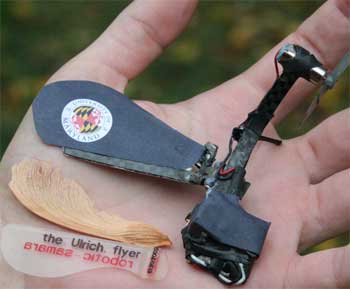Aerospace engineering graduate students at the University of Maryland’s Clark School of Engineering have mimicked the design of the maple seed, or samara fruit, to create the world’s smallest controllable single-winged rotorcraft.
In the 1950s, researchers first tried to create an unmanned aerial vehicle that could mimic a maple seed’s spiralling fall. Ever since, their attempts have been foiled by instability, resulting in a lack of control over the tiny vehicles, which were easily knocked off course by wind. As recently as June 2009, this was considered as an open challenge for engineers.
The Clark School students have solved the steering problem and provided a solution that allows the device to take off from the ground and hover, as well as perform controlled flight after its initial fall to the ground when deployed from an aircraft. The device can also hover during its initial descent, or after being launched by hand.
The maple-seed-inspired design is valuable because when dropped, unpowered, from a plane and then controlled remotely, it could perform surveillance manoeuvres for defence, fire monitoring and search-and-rescue purposes.
’Natural maple seeds usually trade off altitude for rotation as they fall to the ground,’ said Evan Ulrich, one of the graduate students on the team. This altitude-rotation trade-off results in the power that the seeds need to travel. But this traditional design does not provide enough power to allow the device to hover.’
Ulrich and other graduate students in the research group led by Clark School Dean Darryll Pines, a professor in the Department of Aerospace Engineering, incorporated a new part to their device, a curved, comma-shaped component in the body of the device, which provides more stability and gives the device power to hover. They have two patents pending on their innovation.





April 1886: the Brunkebergs tunnel
First ever example of a ground source heat pump?